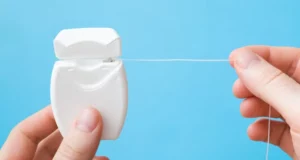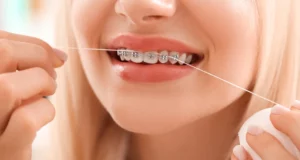Last Updated on: 11th June 2024, 08:06 am
✓ Fact Checked 🕓
❙ Our team of writers, editors, and medical experts rigorously evaluates each article to ensure the information is accurate and exclusively cites reputable sources.
❙ We regularly assess how the content in this article aligns with current scientific literature and expert recommendations in order to provide the most up-to-date research.
Many people feel self-conscious because when they smile they show too much gum and few teeth; this condition is called a “gummy smile”. The teeth look much smaller compared to the size of the gum; but those who present this appearance can rest assured since it is possible to reshape the gums to show off a beautiful smile with a procedure known as gingival contouring or gingivoplasty.
Gum contouring is a cosmetic dental treatment that helps correct the gum line, improving the overall appearance of the smile. In this article, you will find information about this procedure, and what to expect during and after surgery.
What is gum contouring?
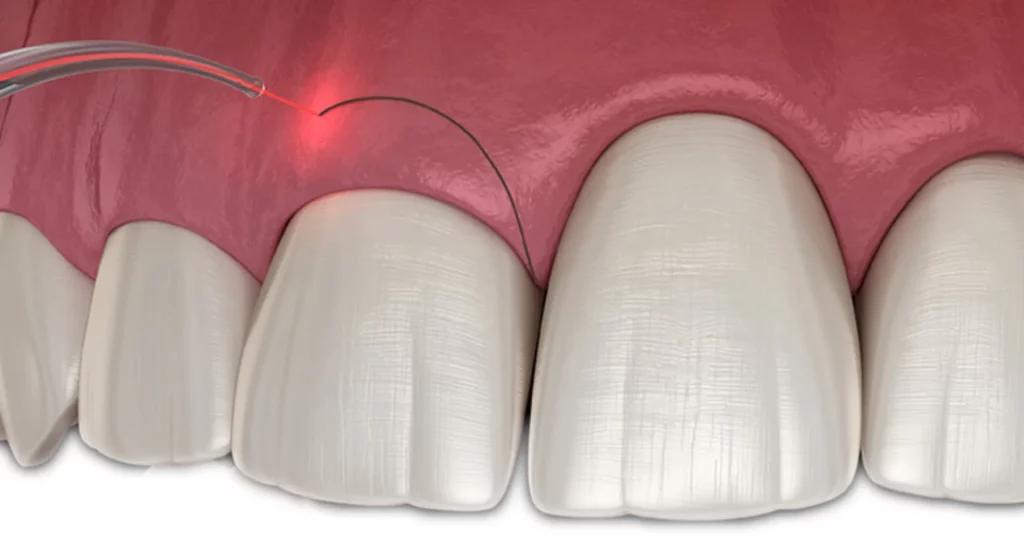
It is a type or oral surgery performed by a dentist or periodontist in which the gum line is reshaped, that is, excess gingival tissue around the teeth is removed.
This procedure can be performed on one or several teeth, using a traditional scalpel, an electrocautery or with laser surgery. The dentist places local anesthesia, marks the gum, and defines how far the cut goes. He then removes the excess gum soou will see more tooth surface and a more even gum line, giving the impression of larger teeth.
The advantages of electrocautery and laser is that the specialist can make finer cuts, there is less bleeding, and surgery and recovery time are also reduced.
Guml contouring is often performed with other dental procedures, such as veneers and teeth whitening to achieve the most cosmetically acceptable smile for both the patient and the dentist.
Who can perform gum contouring?
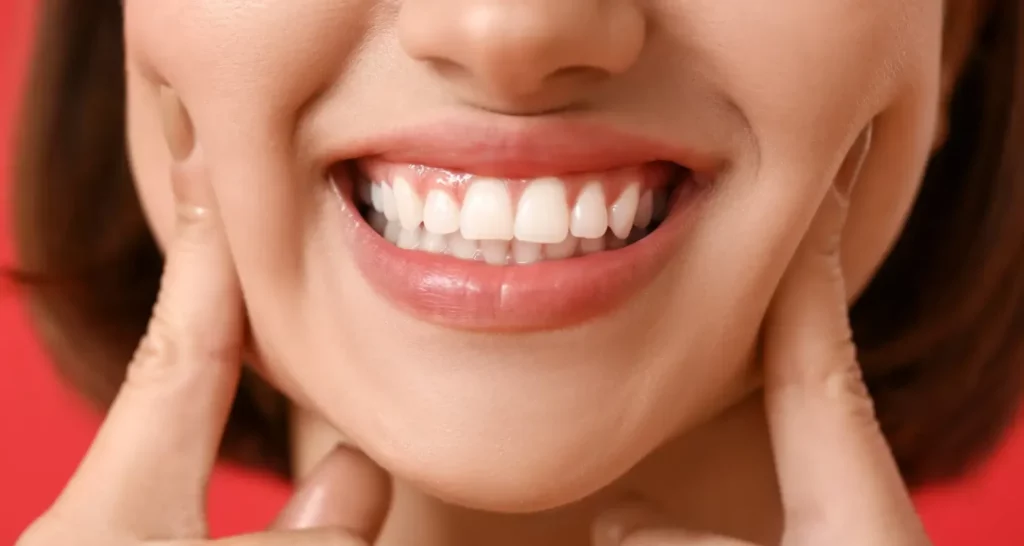
The dentist will evaluate the general and oral condition of each patient to determine if he or she is a candidate for gum contouring. Of note, this is generally a safe procedure for adults.
In most cases, this is an aesthetic procedure performed to improve the appearance of the gums and achieve a more harmonious smile in those who have enlarged gums or a gummy smile, either due to the consumption of certain medications or as a result of genetics.
When the patient presents gum diseases such as gingivitis or periodontitis, performing gum contouring will help control the progression of the disease and reduce the risk of dental caries.y By performing the surgery, the teeth disappear or are reduced, including the “pockets” formed between the tooth and the gum that accumulate food and bacteria.
The consumption of medications such as anticonvulsants, immunosuppressants and calcium channel blockers can cause excessive growth of the gums (gingival hyperplasia). That is why it is important to inform your dentist if you are undergoing any medical treatment and what medications you are taking to determine if gingivoplasty is the best option in your case or if a different or additional treatment is preferred.
Benefits of gum contouring

Gingivoplasty offers many cosmetic and oral health benefits:
1. Improves the size of the teeth with respect to the size of the gums: After the procedure the teeth will look bigger and even cleaner.
2. Self-esteem: Having a harmonious and healthy smile will help you feel better physically and emotionally.
3. Permanent results: The gum removed does not regenerate. With good oral hygiene, the results will be maintained and gum diseases such as gingivitis or periodontitis will not appear.
4. Short procedure: Both surgery and recovery last a short time.
5. Decreases the probability of developing cavities and periodontal problems: Excess gum tissue traps food particles that are difficult to remove with brushing and flossing, leading to periodontal pockets, gum inflammation and bleeding, bone loss, tooth mobility, and cavities below the gums line.
6. Safe procedure
Risks and complications of gum contouring

Every surgical procedure carries risks and complications; in the case of gingivoplasty, they can be:
● Tooth root exposure
● Increased tooth sensitivity
● Poor healing
● Infection
● Lack of symmetry
● Allergy to anesthesia
Postoperative care
Recovery time is usually between one to two weeks; You may experience a certain degree of discomfort, which varies from one patient to another. It is likely that the gums and teeth remain sensitive to acidity and touch.
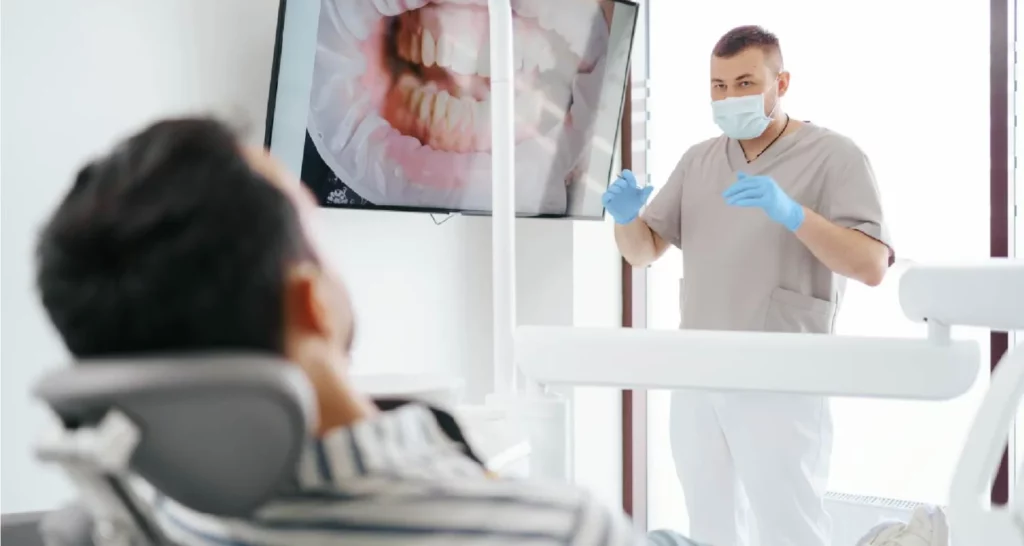
Some recommendations to keep in mind are:
● On the day of surgery, rest and avoid strenuous or outdoor activities.
● Consume soft foods for 2 or 3 days such as soup, creams, ground meat, yogurt, gelatin, and juices, among others.
● Avoid consuming spicy, acidic or hard foods, as these can irritate, scratch or inflame the gums.
● Use chlorhexidine rinses for a maximum of 2 weeks.
● You will brush your teeth (in the designed surgery area) following the intervention with a specific brush that the dentist will teach you how to use.
● The dentist can prescribe antibiotics and analgesics to manage infections and pain.
● Do not take aspirin, as it can cause excessive bleeding.
● Attend scheduled control appointments to verify the results of the surgery.
● In case of suppuration, redness, burning or itching, schedule an urgent consultation for review and treatment.
If the patient is in good mucogingival health before surgery and agrees to follow the care required after the intervention, the recovery will be fast, effective, and without incident.
Guml contouring is a very good treatment from an aesthetic and oral health point of view. Those who undergo this surgery must take into account that maintaining adequate oral hygiene and consulting the dentist periodically is essential to the success of the procedure.
The risks of gum contouring are minimal. In fact, the surgery is quite safe when performed by the right professional. If you notice your gums are very large and/or your teeth are very small – and you think you need gingivoplasty – ask your dentist if you are a candidate. The results may surprise you.
Insurance generally does not cover this surgery because it is an aesthetic procedure.
Conclusion
Gum contouring, or gingivoplasty, is a safe and effective cosmetic dental procedure that reshapes the gum line to create a more aesthetically pleasing smile. It can help reduce the appearance of a “gummy smile” and improve overall oral health. While there are some minor risks associated with the procedure, these are rare when performed by a qualified dentist. If you are considering gum contouring, consult with your dentist to discuss your options and determine if it is the right treatment for you.
Key Points:
● Gum contouring improves smile aesthetics by reshaping the gum line.
● It can reduce the appearance of a “gummy smile” and promote oral health.
● The procedure is safe and effective when performed by a qualified dentist.
● Consult with your dentist to determine if gingival contouring is right for you.
Frequently Asked Questions
What are the disadvantages of gum contouring?
Like any surgical procedure, the primary concern with gum reshaping is the potential risk of infection. Additionally, there is a possibility of having an adverse reaction to the anesthesia administered. It is crucial to choose a trustworthy dentist for gum contouring to minimize the likelihood of complications.
Is it possible for gum contouring to have negative outcomes?
Although there are limited instances of long-term complications arising from contouring, it is essential for patients to attend follow-up appointments to allow doctors to monitor the progress of healing. Temporary discomfort may be experienced during the contouring process, but the occurrence of complications related to gum contouring is minimal.
When is it safe to brush my teeth following gum contouring?
The typical healing period ranges from one week to ten days. In the following guidelines, we will explore several measures to expedite your recovery. Oral Hygiene: It is crucial to handle brushing and flossing with utmost care for a few weeks after undergoing gum contouring.
Is it possible for gums to regenerate after gum contouring?
Do the effects of gum contour last forever? In most cases, the outcomes of gum contouring are permanent and do not require additional procedures. Generally, once the gums have been reshaped, they do not grow back. Consistent oral hygiene practices and regular teeth cleaning can aid in preventing future irritation or recession.
Share:
References
1. Burch, K. (August 23, 2022). Everything You Need to Know About Gum Contouring. Verywell Health. https://www.verywellhealth.com/gum-contouring-5323782
2. Higuera, V. (February 11, 2020). What Is Gum Contouring and Why Is It Done? Healthline. https://www.healthline.com/health/gum-contouring
3. Marks, H. (Reviewed: September 14, 2021). Gum Contouring Surgery: For Gums That Are Too High or Too Low. WebMD. https://www.webmd.com/oral-health/guide/gum-contouring-procedure
4. Moura, D., Lima, E., Lins, R., Souza, R., Martins, A., & Gurgel, B. (2017).The treatment of gummy smile: an integrative review of the literature. Clinical Journal of Periodontics, Implantology and Oral Rehabilitation, 10(1), 26–28. https://doi.org/10.4067/s0719-01072017000100026
5. Nall, R. (July 31, 2020). Everything to Know About a Gingivoplasty. Healthline. https://www.healthline.com/health/dental-and-oral-health/everything-to-know-about-a-gingivoplasty
6. Narayanan, M., Laju, S., Erali, S., Fathima, AZ., & Gopinath, PV. (2015).Gummy Smile Correction with Diode Laser: Two Case Reports. PubMed Central (PMC). https://www.ncbi.nlm.nih.gov/pmc/articles/PMC4672859/









